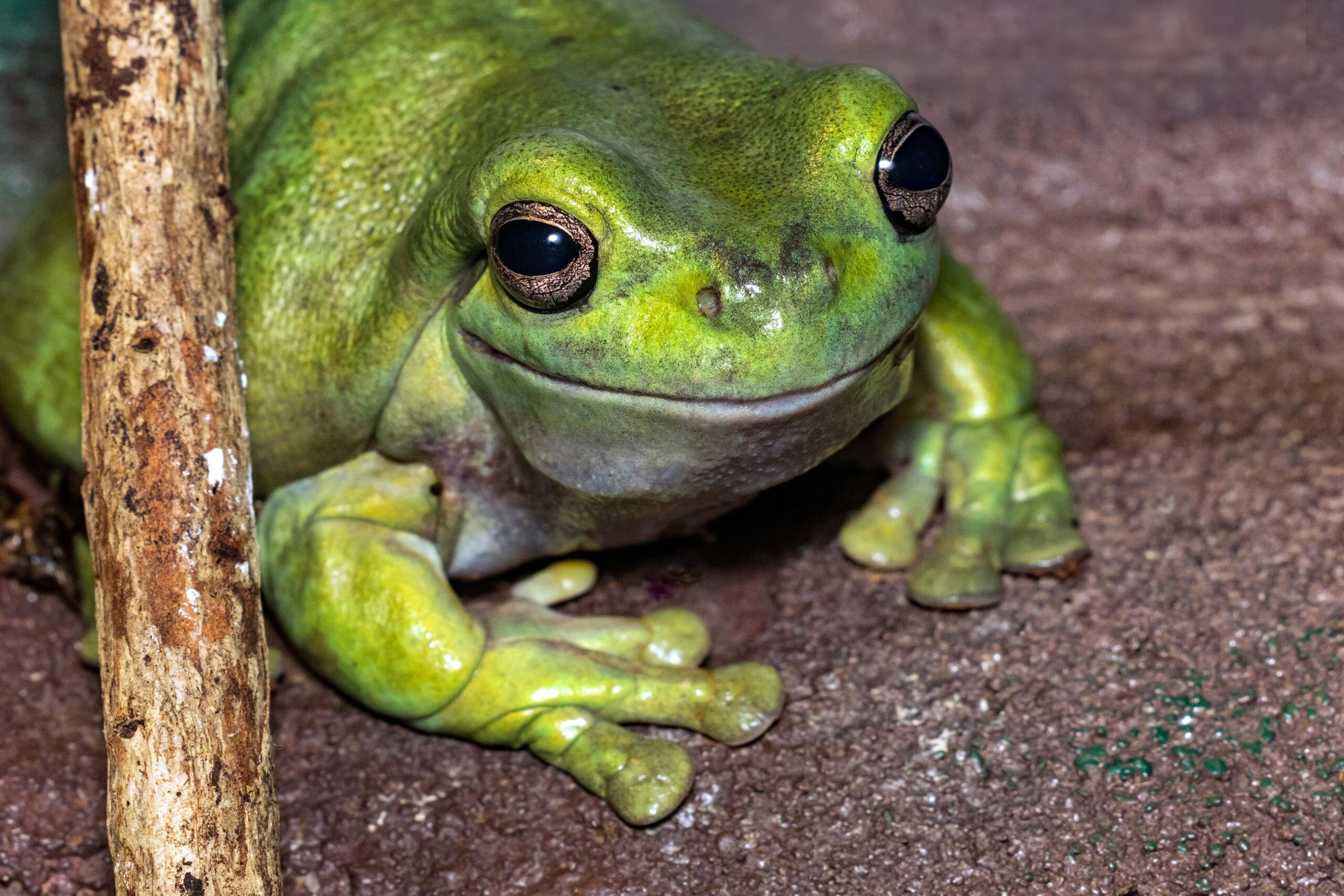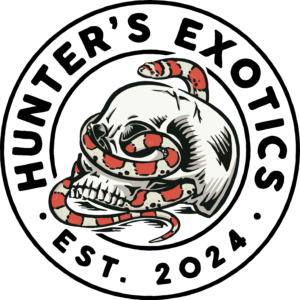Litoria caerulea
Species Overview
White’s Tree Frogs are hardy, arboreal amphibians native to Australia and New Guinea. Known for their adaptability and calm disposition, they are ideal for both novice and experienced amphibian keepers. Their thick, waxy skin helps them retain moisture in drier environments, and their large size and gentle temperament make them a popular display species.
Care Level: Beginner to Intermediate
Adult Size: 3–5 inches (females typically larger)
Average Lifespan: 10–20 years in captivity
Activity Pattern: Nocturnal
Temperament: Docile, relatively tolerant of occasional handling
Enclosure Setup
White’s Tree Frogs thrive in vertically oriented enclosures with high humidity and good airflow. A bioactive setup is ideal for long-term health and environmental enrichment.
Minimum Enclosure Size: 18″ x 18″ x 24″ for 1–2 adults
Terrarium Type: Front-opening glass terrarium with mesh ventilation
Substrate: Moisture-retentive mix such as coco fiber, sphagnum moss, or a bioactive soil layer over LECA
Structural Elements: Branches, cork tubes, and large-leafed live plants for climbing and hiding
Plant Suggestions: Pothos (Epipremnum aureum), bromeliads, Majesty Palm, snake plant (Sansevieria)
Water Source: Shallow dish with dechlorinated water; avoid deep bowls to prevent drowning
Environmental Parameters
Daytime Temperature: 75–82°F (24–28°C)
Nighttime Temperature: 65–75°F (18–24°C)
Humidity: 50–70%; mist lightly once or twice daily
Lighting: Low to moderate UVB (5.0) is beneficial but optional; maintain a 12-hour light/dark cycle
Diet and Feeding
White’s Tree Frogs are opportunistic insectivores that benefit from a varied, well-supplemented diet.
Primary Food Items: Gut-loaded crickets, dubia roaches, mealworms; offer waxworms or silkworms as treats
Feeding Frequency: Juveniles—daily; Adults—every 2–3 days
Supplements: Calcium with D3 twice per week; multivitamin once per week
Note: Monitor food intake to prevent obesity, a common health issue in captive frogs
Maintenance and Hygiene
Daily: Remove uneaten insects and waste; refresh water dish
Weekly: Wipe down glass and décor
Monthly: Replace substrate or maintain bioactive layers
Water Quality: Use only dechlorinated or spring water
Behavior and Handling
Behavior: Nocturnal, semi-arboreal, calm climbers
Handling: Minimal handling recommended; always wash hands before and after contact
Social Housing: Can be kept alone or in groups if enclosure is large and well-structured
Breeding Information
Sexing: Males are smaller with dark throats and a croaking call; females are larger and more robust
Breeding Setup: Simulate a rainy season with higher humidity and slight temperature drops
Reproduction: Females lay eggs near water; raise tadpoles in clean, well-oxygenated aquatic setups
Health Considerations
Common Issues:
Fungal infections (e.g. chytrid)
Obesity from overfeeding
Bacterial infections from poor hygiene
Veterinary Care: Seek exotic animal vets for any signs of illness
Recommended Supplies
Vertical glass terrarium (18″x18″x24″ or larger)
Digital thermometer and hygrometer
Coco fiber, sphagnum moss, or bioactive substrate
Live plants: pothos, bromeliads, Majesty Palm
Climbing décor: cork bark, branches
Shallow water dish with dechlorinated water
Low-level UVB lighting (optional)
Calcium and vitamin supplements
Spray bottle or automated misting system
Hunter’s Tip
Maximize vertical space with live vines like pothos. It enhances natural behavior, helps maintain humidity, and looks incredible in display tanks.
Hunter’s Picks
MistKing Misting System — Premium, programmable misting solution perfect for amphibians and bioactive enclosures
Reptizoo Mister (Budget Option) — Simple, effective, and affordable misting system for beginners
Zoo Med Repti Calcium with D3 — Reliable calcium supplement to support healthy bone development
Reptizoo Hygrometer & Thermometer Combo — Easy-to-read tools to track temp and humidity levels
Coconut Soil & Sphagnum Moss — Ideal substrate base for moisture retention and burrowing
Reptizoo Front-Opening Glass Terrarium — Durable, well-ventilated tank designed for amphibian needs
Purchasing through these affiliate links supports Hunter’s Exotics at no extra cost to you. Thank you!



